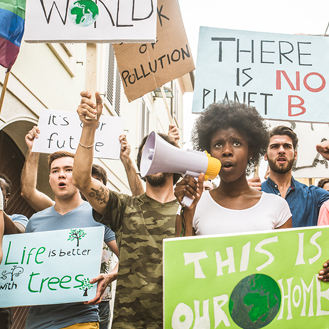
December 6, 2023
By Taylor Caton, Drexel University College of Medicine
Rising temperatures, sinking cities and increased natural disasters show the necessity of addressing climate change today. While these issues have sparked a global uproar and propelled action among world leaders, an insidious component of climate change lurks beneath the surface of melting ice and raging fires. Climate change highlights inequality and demonstrates the vulnerability of certain regions and populations. The Intergovernmental Panel on Climate Change (IPCC) found that people who are already vulnerable and marginalized are impacted the most by climate change, especially those who rely on natural resource sectors like agriculture. Consequently, gender inequality is exacerbated, and women bear the greater burden of climate change.
There are many contributing factors that cause climate change to adversely affects women more than men. Research has shown that about 70% of the 1.3 billion people living in poverty are women, and women compose a large part of communities highly dependent on local natural resources for livelihood.1 In many of these regions, women bear the responsibility for securing food, water and fuel.2 Agriculture is a particularly important employer of women in low-middle income countries, with women comprising 50-80% of the labor for the world’s food production.2 When extreme weather conditions cause droughts, floods or other natural disasters, women often work more to secure household needs, leaving less access to training, education and sources of income.2 Women are less likely to survive natural disasters, and migration and seeking refuge can be hampered by lack of information, mobility struggles and the need for childcare. In these cases, many young girls are pressured to leave school to help their families, continuing cycles of vulnerability.
Additionally, climate change exacerbates gender-based violence. Due to greater vulnerability and displacement, women are at an increased risk of sexual violence, exploitation and trafficking.3 Food insecurity and household stress increases risk of intimate partner violence.3 Similarly, malnutrition can lead to maternal depression, anemia, and adverse pregnancy and neonatal outcomes.3 In fact, pregnancy and neonatal outcomes are negatively impacted by climate change for a multitude of reasons besides changes to income and food security. Increased maternal heat exposure is associated with risk of preterm birth, low birthrate, stillbirth and congenital fetal anomaly.3 In the United States, some areas are expected to have up to a 60% increase in fetal heart defects by 2035 due to heat exposure.3 Maternal health is also affected, with increased likelihood of hypertension and placental abruption.3 Climate change increases vector-borne illnesses due to changes in temperature, water level fluctuations and prevalence of new or emerging species. Zika virus in particular is expected to flourish in North American and Europe and is predicted to affect 1.3 billion people by 2050. Zika virus is notably associated with microcephaly and birth defects when women are exposed during pregnancy.
Overall, climate change is not gender neutral and disproportionately affects women. A conscious effort needs to be made to raise awareness of these effects and to combat the devastating effects of climate change to our world.
Sources/Resources:
- Osman-Elasha, B. (n.d.). Women...in the shadow of climate change. United Nations. Retrieved January 21, 2023, from un.org/en/chronicle/article/womenin-shadow-climate-change
- 2022, 28 F. (2022, February 28). Explainer: How gender inequality and climate change are interconnected. UN Women – Headquarters. Retrieved January 21, 2023, from unwomen.org/en/news-stories/explainer/2022/02/explainer-how-gender-inequality-and-climate-change-are-interconnected
- Giudice, L. C., Llamas‐Clark, E. F., DeNicola, N., Pandipati, S., Zlatnik, M. G., Decena, D. C., Woodruff, T. J., & Conry, J. A. (2021). Climate change, women’s health, and the role of obstetricians and gynecologists in leadership. International Journal of Gynecology & Obstetrics, 155(3), 345–356. doi.org/10.1002/ijgo.13958